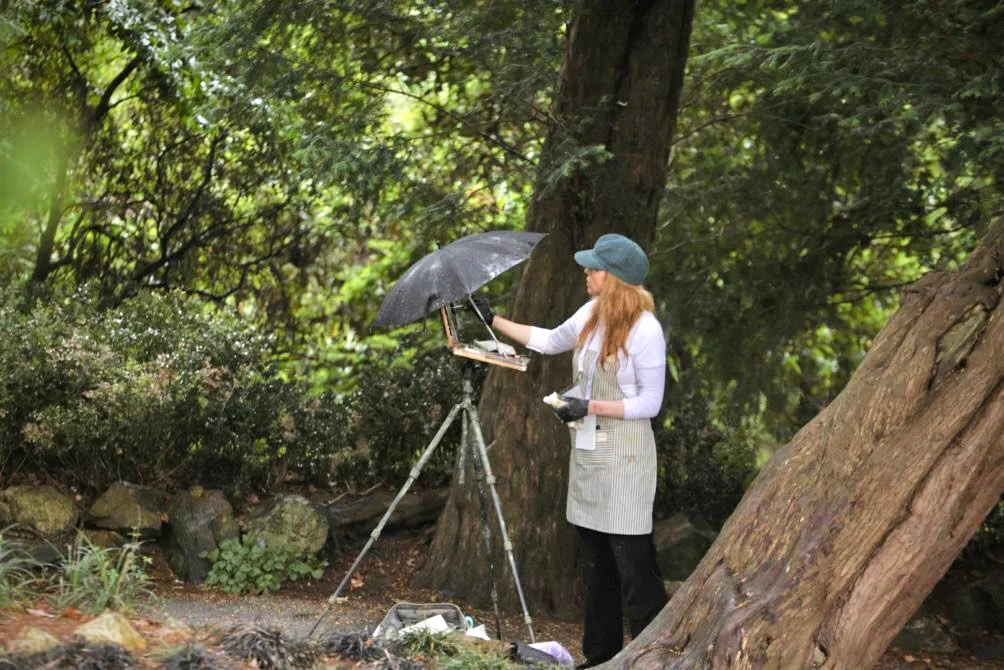The Importance of Composition in Plein Air Painting

Plein air painting is one of my favorite ways to connect with nature, but it also comes with its own set of challenges. Unlike studio work, where I have more time to carefully plan each decision, plein air painting requires me to think quickly. In this post, I’ll share how I approach composition while painting outdoors, with a focus on balance and how I structure the scene to create a cohesive and engaging painting.
Introduction: The Challenge of Plein Air Composition
When I’m painting outdoors, I’m constantly adjusting to changing light and weather, which means I need to make quick decisions about composition. Sometimes, I begin by focusing on a focal point, but other times, I start by looking at how different elements fit together as a whole. The goal is always to create a painting that feels balanced and harmonious, no matter how I approach the composition.
1. Assessing the Scene
The first thing I do when setting up to paint is to step back and take in the whole scene. Rather than focusing on one specific object or area, I look at the relationships between the various elements.
- What to Look For:
- How are the shapes and lines arranged? What feels balanced or unbalanced?
- How is the light affecting the scene? The light helps define shapes and adds contrast, so I pay close attention to how it highlights certain areas and creates shadows.
- I also think about what I can leave out. Nature is full of detail, but simplifying the scene helps make the composition clearer and more focused.
Tip: While starting with a focal point is a great way to structure a painting, I often let the scene develop as I go, responding to the landscape in the moment.
2. Balancing the Elements
As I begin to lay out the composition, I think about how to balance the various elements. A key part of plein air painting is managing the relationships between foreground, middle ground, and background.
- Creating Flow:
- I look for lines in the scene—such as roads, rivers, or tree lines—that guide the viewer’s eye through the painting.
- Diagonal lines can add energy, while horizontal lines create a sense of calm and stability.
- I also think about how different shapes and forms balance each other. For example, a large tree in the foreground might need a smaller, distant shape to provide counterweight.
3. Working with Light and Shadow
One of the things I love most about plein air painting is how the light transforms the scene. The changing light provides natural contrasts between light and shadow, which play a huge role in composition.
- Light as a Compositional Tool:
- The way light interacts with shapes can direct the viewer’s attention and define the structure of the painting.
- While I often start with a focal point, I also pay attention to how light creates balance across the entire composition, ensuring that no area is too heavy or too empty.
4. Creating Atmospheric Perspective
To enhance the depth of the scene, I emphasize and sometimes exaggerate the elements needed to create atmospheric perspective.
- Emphasizing Depth:
- I adjust the colors and values, making the distant elements lighter and less saturated, while the foreground remains richer and more detailed. This helps establish the illusion of depth.
- I also pay attention to the contrast between foreground and background, where stronger contrasts up close fade as they recede into the distance.
- Occasionally, I may exaggerate the fading of colors and details in the distance to make the scene feel even more expansive and atmospheric. This technique can add a sense of realism and transport the viewer into the scene.
5. Simplification and Decision-Making
The best way to keep things from feeling cluttered in plein air is simplification. There’s so much going on in nature, but I need to make decisions about what to include and what to leave out to maintain a clear composition.
- Tip: I start by blocking in large shapes and values, then refine the details as I go. This keeps the composition from feeling too busy and helps maintain focus.
Conclusion
Plein air painting is a dynamic and spontaneous experience. Whether I start with a focal point or let the composition evolve as I paint, the goal is always to create a balanced and cohesive piece. By paying attention to how elements interact, using light to guide the composition, and simplifying the scene, I can create paintings that feel grounded and complete. Adding atmospheric perspective, whether by emphasizing or exaggerating certain elements, further deepens the sense of space and invites the viewer to experience the landscape as I see it in the moment.